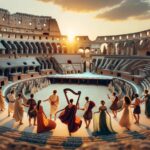Dionysus Takes Center Stage: Deconstructing the Paris 2024 Opening Ceremony Debate
The opening ceremony of the Paris 2024 Olympics, held on Friday, July 26, 2024, sparked unexpected controversy surrounding a tableau featuring French singer Philippe Katerine portraying Bacchus, the Roman god of wine. While intended as a tribute to Dionysus, the Greek counterpart of Bacchus, and his mythological ties to France, the scene’s resemblance to Leonardo da Vinci’s “The Last Supper” ignited a firestorm of criticism online. Some viewers, particularly those with conservative religious beliefs, interpreted the performance as a deliberate mockery of Christianity. This misinterpretation quickly spread through social media, prompting a swift response from Olympic organizers.
The Dionysus Connection to France: A Celebration of Heritage?
Artistic director Thomas Jolly clarified the scene’s true meaning, emphasizing its connection to Greek mythology and French heritage. Dionysus, in Greek mythology, is the father of Sequana, the goddess of the Seine River, which flows through Paris. This mythological link provided a thematic justification for including Dionysus in the opening ceremony, intertwining ancient Greek lore with Parisian identity. The long table, laden with goodies and wine glasses, aimed to evoke a Dionysian feast, a celebration of revelry and abundance. The presence of a woman with a silver crown probably represented Sequana or a broader concept of festivity, and drag queens, often associated with theatrical performance and celebration, likely symbolized the exuberant spirit of Dionysian revelry. Be amazed by our meticulous collection of ancient artifacts in our renowned antiquità section, where masterpieces from bygone eras await your exploration.
The “Last Supper” Resemblance: An Unintentional Parallel?
Despite Jolly’s explanation, the controversy persisted. The visual arrangement of figures at a long table, reminiscent of Da Vinci’s “Last Supper,” fueled the misinterpretation. It is important to note that interpretations of art are often subjective. While some viewers might have seen a resemblance to “The Last Supper,” the performance lacked key elements from Da Vinci’s painting, such as bread, wine distributed to disciples, and recognizable disciples. These omissions suggest the scene wasn’t trying to recreate “The Last Supper”. Dive into the captivating world of bacchanal painting and uncover the intoxicating allure of revelry and indulgence depicted on the canvas. Perhaps the scene unintentionally resonated with multiple narratives simultaneously, sparking diverse reactions. Further research into the symbolism used in the ceremony might reveal additional layers of meaning. This ambiguity is part of what makes art so fascinating.
The Olympic Committee’s Response: Apology and Reaffirmation
On Sunday, July 28, 2024, Paris 2024 spokeswoman Anne Descamps addressed the controversy, apologizing for any unintended offense while defending the artistic intent. The apology wasn’t for the performance itself, but for the unintended offense caused by its misinterpretation. The Committee recognized that the performance, however unintentionally, led to some feeling hurt and offended, and they responded with an apology for that hurt. This act of acknowledging public sentiment while upholding artistic expression highlights the complexities of presenting potentially ambiguous art on a global stage.
The Role of Social Media: Amplifying Misunderstandings
The “Last Supper” comparison rapidly spread through social media, amplifying the misinterpretation and fueling the controversy. Out-of-context images and short video clips further exacerbated the situation, highlighting the speed and potential for distortion inherent in online communication. The incident underscores the importance of verifying information and seeking diverse perspectives before drawing conclusions.
Dionysus: A Symbol of Peace? Reinterpreting the Performance’s Message
The Olympics’ official X (formerly Twitter) account stated the scene was an interpretation of Dionysus, chosen to highlight the absurdity of violence and promote peace. This interpretation aligns with some scholarly views of Dionysus, who, despite his association with revelry, also represents themes of unity and transformation. This adds another layer of complexity to the controversy, raising questions about how ancient myths can be reinterpreted in contemporary contexts.
The Broader Context: Art, Culture, and Interpretation
The Bacchus/Dionysus controversy highlights several crucial points:
- Cultural Sensitivity: It underscores the need for cultural sensitivity and understanding different perspectives when interpreting artistic expression, especially on a global platform like the Olympics.
- Artistic Freedom vs. Public Perception: The incident raises questions about the balance between artistic freedom and the potential for offense, particularly when dealing with sensitive cultural or religious themes.
- The Power of Social Media: The controversy demonstrates how rapidly misinformation can spread online, influencing public opinion and potentially distorting the intended message of artistic works.
- The Importance of Context: Understanding the historical and mythological context of the performance is crucial for accurate interpretation. Superficial comparisons can lead to misleading conclusions.
The controversy surrounding the Bacchus/Dionysus tableau at the Paris 2024 Olympics opening ceremony serves as a valuable reminder of the complexities of artistic interpretation, the power of social media, and the importance of seeking deeper understanding before rushing to judgment. It also suggests that ongoing research and evolving interpretations of ancient myths continue to shape our understanding of art and culture.
- Unlocking 2-Letter Words with U: The Definitive Guide - April 4, 2025
- Unlock Words with the Letters THREE: Top Unscramble Tools 2025 - April 4, 2025
- Master Scrabble: X & Z Words for High Scores - April 4, 2025
















